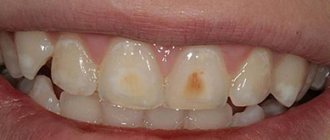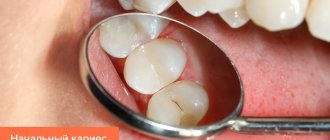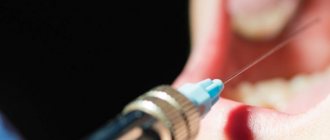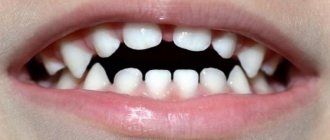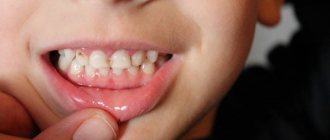The key to health is proper body care from childhood. This also applies to the oral cavity.
Parents should closely monitor the condition of the child's oral cavity. But sometimes, despite all efforts, proper care and a healthy diet, you may notice a deterioration in the condition of your teeth. A common problem is the presence of a yellow coating on them. Often parents consider this situation to pass and not require attention or treatment. And this is wrong! Yellow plaque on a child’s teeth can be either a symptom of problems in the body or an independent disease, which, if left untreated, can lead to various complications in the future.
Causes of yellow teeth
Experts note that a child’s body, which is just beginning to function normally, is influenced by many negative external factors. Together they can lead to various disorders. Dentists identify a number of reasons why yellow plaque may form on a child’s teeth, namely:
- improper diet;
- drug treatment;
- insufficient hygiene;
- internal diseases;
- congenital problems;
- heredity.
If we talk about food, then the diet of both an adult and a child should be balanced. Of course, you cannot deprive your child of tasty but not very healthy foods, for example, sweets. But, nevertheless, fruits and vegetables, including raw ones, should prevail in the children's diet. In addition to the fact that they are rich in vitamins and minerals vital for the healthy and full development of the body, they also mechanically clean teeth of various plaque.
The less dyes, chemicals and sugar in food, the healthier and safer it is for the child. The more food is processed and far from its original state (convenience foods, sausages, sweets, flour products), the worse it affects teeth and gums.
Some antibiotics and other medications can stain teeth. Long-term use of medications carries the risk that the enamel may turn yellow. As a rule, after completing the course of treatment, the body cleans the teeth on its own. And after some time, the baby’s smile is snow-white again.
The next reason why yellow spots may appear on the teeth of a one-year-old child and older is improper oral hygiene. If you neglect it, a soft plaque may form on your baby’s teeth. It is this that gives the yellowish tint. In addition, it is a beneficial environment for the proliferation of various bacteria, which can lead to caries and other extremely unpleasant problems in the oral cavity.
If a child is not accustomed to brushing their teeth thoroughly and regularly, this will cause many problems in the future. One of the most important tasks of parents is to instill in their child the habit of constant care of their own oral cavity. The baby should be able to brush his teeth, know when to do it, and be familiar with the basic rules of oral hygiene from early childhood! And parents should unobtrusively control the process of brushing their teeth - perform this hygienic procedure together; make a habit of smiling after brushing your teeth to see if the baby has coped with the task assigned to him, etc.
Often yellowing of teeth signals internal problems in the body. For example, about problems with metabolism, disorders of the gastrointestinal tract or thyroid gland. If your teeth suddenly turn yellow, and this is not due to taking medications or poor nutrition, consult a doctor. He will identify the cause of yellowing of the enamel.
Often the reasons why a child’s chewing teeth or incisors are yellow are congenital. If you or your relatives have yellow tooth enamel, and this is not associated with disease or poor hygiene, the color may be hereditary.
Your baby’s teeth may turn yellow if, during pregnancy, the mother:
- pathologies developed;
- there were infectious diseases;
- severe manifestations of toxicosis were observed;
- had an unbalanced diet.
In addition, factors such as:
- prematurity of the baby;
- conflict of Rh factors of mother and child during pregnancy;
- birth injuries;
- hemolytic pathologies.
If the body's formation of enamel or dentin (the layer of teeth that is under the enamel and has a yellowish tint) is disrupted for any reason, this will likely lead to staining of baby and even permanent teeth. This can happen if for some reason the layer of enamel on the teeth is too thin, “transparent”.
Treatment of stains on teeth at the dentist
Regardless of the color of the stain on the tooth, the best solution is to consult a doctor. The dentists of the Elitedental M clinic will conduct the first free examination and prescribe the treatment necessary for your case.
The set of procedures depends on the cause of the spots:
- The most common, carious ones, are treated using special solutions that restore tooth enamel. The same restoration method is used for enamel hypoplasia.
- If the cause of the stain is tartar or plaque, the dentist will carefully remove it and apply a protective fluoride varnish.
- Chemical, laser and photo whitening help even out the shade of tooth enamel.
- The aesthetics of teeth is restored by installing cosmetic crowns.
- If there is a lack of minerals and salts, treatment is prescribed. The doctor prescribes calcium supplements and vitamins, and gives recommendations on the choice of medicinal paste.
How to get rid of yellow plaque on children's teeth?
The main thing is to determine why the child has yellow teeth. And, based on the causes of the problem, begin a comprehensive fight against it.
It is important to understand that even if baby teeth turn yellow, it means that something is wrong in the body. Yes, baby teeth will be replaced by permanent teeth. But the problem will remain and will only get worse over time.
What to do to cope with yellowing of teeth in a child 1-2 years old or older?
Watch your diet
First of all, you need to pay attention to the baby’s diet. Tea, sweets, carbonated drinks are the cause of early yellowing of teeth. Additionally, natural foods such as pumpkin can also stain enamel. It is important that the diet is balanced. It is important that the child eats not only soft, but also hard vegetables and fruits. This will not only cleanse your teeth of plaque, but also strengthen them.
Teach hygiene skills
It is necessary to teach your child how to properly brush his teeth on his own and monitor this process. Paste and brush, mouth rinses and other hygiene equipment should be appropriate for the baby’s age.
To maintain oral hygiene, it is recommended to use cleansing wipes, for example, Asepta Baby, made in the form of a fingertip. They gently cleanse teeth and gums of plaque and disinfect the oral cavity.
After the child has 5-6 teeth, you can start brushing them. It is important that parents themselves know how this process should proceed correctly. You can consult your dentist before starting.
It is also important to choose suitable hygiene products, for example, Asepta Baby toothpastes for children with a reduced amount of fluoride in the body and special toothbrushes for their first teeth. The cleaning process must be supervised by adults.
To quickly get rid of yellow teeth, dentists recommend using one of the following methods:
- Mechanical cleaning. It is suitable for cleaning permanent teeth and should be performed by a specialist. This procedure cannot be carried out frequently. In addition, it is contraindicated for those whose teeth have turned yellow due to the thinness of the enamel.
- Use of bleaching agents. They are either used in the form of ointments, or they are offered to rinse the mouth. The effect from them comes more slowly than from mechanical cleaning, but in general they are a more gentle method of whitening. Attention: whitening products have age restrictions! Consult a specialist before using them!
- Use of ultraviolet lamps. This method is especially effective if the teeth have turned yellow due to the use of antibiotics or an unhealthy diet with an abundance of sugar or food coloring.
- Coating teeth with special solutions. For example, silver or fluoride varnish. This will not only solve the problem of yellowness, but also protect the enamel from possible caries or other damage. Also recommended for permanent teeth.
Possible complications and consequences
Hypoplasia of tooth enamel without timely treatment contributes to the development of caries. An underdeveloped enamel layer does not protect dentin from the aggressive action of an acidic environment; the carious process quickly reaches the pulp and tooth root. Even in the absence of caries, teeth with thinned enamel and chips react with pain to cold, salty and sweet foods. Unpleasant yellow-brown spots disrupt the aesthetics of a smile. The enamel layer with a damaged structure quickly wears off and chips, and malocclusion develops.
Is yellowness normal or pathological?
Not every yellowness should be perceived as a deviation from the norm. Sometimes, due to hereditary factors, a child’s enamel becomes more transparent than that of other children. The lack of white pigment causes the dentin to show through, resulting in darker teeth.
Some dentists are inclined to believe that it is better not to correct or whiten such enamel. At least until the child reaches adulthood and hard tissues are fully formed.
If yellow teeth are showing signs of health, the best thing you can do for your baby is to practice good oral hygiene and good nutrition.
Recommendations from Amel Dental dentists
Beautiful teeth are healthy teeth, and dental health is the result of a patient’s responsible attitude towards their health and oral hygiene.
You can avoid the appearance of unsightly pigment spots on your teeth by following the recommendations of dentists:
- to give up smoking;
- restriction in the diet of coloring drinks and foods;
- restriction in the diet of foods containing acid (citrus fruits, apples);
- balanced diet (sufficient amounts of calcium, vitamin C and other minerals, vitamins necessary for the formation of bone tissue), high-quality drinking water;
- Regular visits to dentistry for the purpose of prevention and timely treatment of caries and other oral diseases.
If stains appear on your teeth, you should not self-medicate, since in most cases, aesthetic defects of the teeth are associated with disorders and diseases within the body. Only a qualified doctor can determine the cause of the pathology and prescribe the correct treatment.
Whitening pastes
Such pastes and gels can be freely purchased in pharmacies, or ordered on the recommendation of your doctor. It is not advisable to use them constantly, since they still have some effect on the enamel. It is best to periodically alternate whitening compounds with medicinal or gum strengthening ones.
With your dentist's approval, you can try home whitening using trays and whitening gels. Such procedures can significantly change the tone of tooth enamel towards white. However, you should not get carried away with this method, since it increases tooth sensitivity and, if used incorrectly, can damage tooth enamel.
How to prevent yellowing of teeth: preventive measures
To avoid the question of how to get rid of yellow plaque, it is better to prevent the problem. As already mentioned, you should give up smoking, carbonated drinks, and coffee. Drinks containing coloring pigments are best consumed through a straw. It is important to neutralize the effect of acids on enamel. To do this, after eating acid-containing foods, you need to rinse your mouth with clean water or drink it or milk. You should also avoid snacking between main meals. This promotes more effective leaching of acids with saliva.
Regular teeth cleaning is one of the main conditions for maintaining a beautiful smile. It is necessary to use dental floss and mouthwash. If you experience dry mouth, you should consult your doctor. Fluoride-containing drugs are taken under strict control.
Is it possible to whiten teeth at home?
Many people often put off visiting the dentist and try to figure out how to remove yellow discoloration on their own. Often advertised and popular whitening pastes come into view today. But it is worth understanding one important point - they contain particles that act on the tooth surface like sandpaper. Mention this. Over time, such pastes damage the enamel, just like those containing activated carbon. Whitening strips sold in pharmacies also have an aggressive composition and do not have the expected effect.
You should not use baking soda and citric acid for whitening purposes - they simply corrode the enamel. What to do to avoid harming your teeth? The best thing to do at home is to practice regular and careful oral hygiene. It is also necessary to exclude from the diet or limit the amount of “bad” foods and drinks consumed and, of course, quit smoking.
Black spots
Tooth degradation of this nature can have several causes. One of them is Priestley's plaque , most often caused by disturbances in the microflora of the children's intestines. As a result, both baby and molar teeth are destroyed by bacteria. The disease can only be treated with medication.
Black spots can also be caused by the development of caries. Blackening of teeth is often a consequence of a lack of calcium in the body. For prevention, you need to reduce the amount of sweets you consume.
In addition, you can increase calcium levels by giving your child more milk and using vitamin complexes prescribed by your dentist.
Much less often, but still possible, this pathology can be inherited from parents. Therefore, the child must have personal cutlery (at least a spoon and fork).
Medical stain removal
To eliminate yellowness of enamel in dentistry, there are many methods used routinely. Before professional removal of yellow stains begins, an examination of the oral cavity is carried out to identify the true cause of the pathology. Patients are often recommended to have their teeth professionally cleaned twice a year.
There are several methods of hygienic treatment:
- laser exposure effectively removes tartar and plaque, splitting them into small particles;
- ultrasonic exposure destroys enamel layers due to frequency vibrations;
- treatment with gel and activator lamp is effective due to the content of hydrogen peroxide in its composition.
If pigmentation is associated with the removal of a nerve or clouding of the filling, various agents are introduced into the dental canal to help whiten the teeth from the inside.
There are times when it is impossible to eliminate yellowness. In this situation, the patient is offered to use veneers or lumineers. Onlays are made according to individual parameters of dental impressions. Since the thickness of such devices is minimal, they are completely invisible on the teeth.
